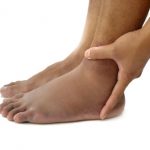 Now that you’re older you’re probably noticing a few more aches and pains. These aches and pains can make completing everyday tasks more difficult. If you’ve noticed that when you’re walking your heel in particular is causing you pain, it’s probably plantar fasciitis.
Now that you’re older you’re probably noticing a few more aches and pains. These aches and pains can make completing everyday tasks more difficult. If you’ve noticed that when you’re walking your heel in particular is causing you pain, it’s probably plantar fasciitis.
Plantar fasciitis is the most common cause of heel pain. It affects a large band of tissue called the plantar fascia. The plantar fascia runs across the bottom of the foot and connects your heel to your toes.
Advertisement
Plantar fasciitis is commonly seen in runners and individuals who are overweight.
Causes, symptoms and risk factors of plantar fasciitis
 Normally, your plantar fascia works like a shock-absorber and supports the arch in the foot. When tension builds up, small tears can occur in the fascia. Stretching and tearing can result in inflammation that hurts.
Normally, your plantar fascia works like a shock-absorber and supports the arch in the foot. When tension builds up, small tears can occur in the fascia. Stretching and tearing can result in inflammation that hurts.
Symptoms of plantar fasciitis include a sharp pain while using the foot – walking, running, standing. This pain is isolated in the heel region. When you wake up, pain may be mild, but with more use and movement, pain can worsen throughout the day.
Aside from being a runner or being overweight, there are other factors that can increase a person’s risk of developing plantar fasciitis. Age, for one, can increase a person’s risk and plantar fasciitis typically affects those over the age of 40. Certain exercises, too, can lead to plantar fasciitis. The structure of your foot can also make a person more prone to plantar fasciitis. If a person is flat-footed or has a high-arch, for example, this can lead to plantar fasciitis. Lastly, if you have an occupation that keeps you on your feet all day that can be a risk factor as well.
Risk Factors
Aside from being a runner or being overweight, there are other factors that can increase a person’s risk of developing plantar fasciitis.
Age: Age, for one, can increase a person’s risk and plantar fasciitis typically affects those over the age of 40.
Exercises: Certain exercises, too, can lead to plantar fasciitis. The structure of your foot can also make a person more prone to plantar fasciitis. If a person is flat-footed or has a high-arch, for example, this can lead to plantar fasciitis.
Occupation: Lastly, if you have an occupation that keeps you on your feet all day that can be a risk factor as well.
Treatment and prevention of plantar fasciitis
 There are three main forms of treatment for plantar fasciitis: Medication, surgery and therapy.
There are three main forms of treatment for plantar fasciitis: Medication, surgery and therapy.
Medication: For starters, pain-reliving medication can be used to minimize the discomfort caused by plantar fasciitis.
Physical therapy and orthotics :Physical therapy, wearing a night splint and orthotics are all forms of therapy that can help ease plantar fasciitis. Orthotics work to fix the structural problems of the foot. An insole is made to complement your foot to better support it. Lastly, surgery may be a form of treatment if the plantar fasciitis is severe.
Surgery :A surgeon may detach the plantar fascia from the heel bone. This method does pose risks as the arch of the foot may become weak. Surgery should only be considered in very severe cases of plantar fasciitis.
Advertisement
Lifestyle habits, too, can help prevent and treat plantar fasciitis. Some effective lifestyle habits to adopt include:
- Maintain a healthy weight
- Always wear supportive shoes
- Don’t wear out your athletic shoes – if you’re active, shoes should be changed every 500 miles
- Change your physical activity – if you’re accustomed to high-intensity training try switching to low-impact exercises such as swimming
- Apply ice – especially after an activity, ice can help minimize inflammation
- Stretch your arches.
These lifestyle tips can help ensure you don’t run into a problem like plantar fasciitis and can continue to enjoy walking and running without pain.
Related: Walking barefoot indoors prevents plantar fasciitis, shin splints, bursitis and tendinitis
